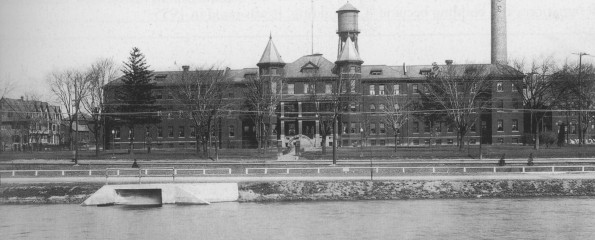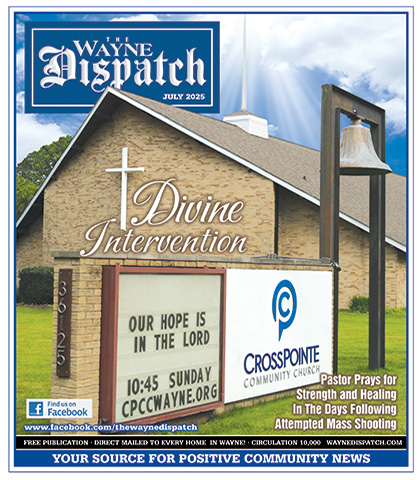History of Eloise
By Darlene Hawley – Wayne Ladies’ Literary Club recently reviewed a book at their book discussion meeting and it brought back a host of childhood memories for those in attendance who grew up in Wayne and surrounding communities. It was a true story called “Annie’s Ghost” written by Steve Luxenberg about a young woman who was placed in Eloise Hospital by her family at a young age and whose existence was kept a secret for many decades until her story was uncovered by a nephew. I remember Eloise. It was a huge complex of buildings enclosed in a tall wrought iron fence that sat on acres of land at Michigan Avenue, Henry Ruff and Merriman Roads for many years. It was a city within itself.
It all began back in 1832 when Wayne County built a poorhouse in Detroit at Gratiot and Mt. Elliott Avenues in Hamtramck. By 1834, this poorhouse was overcrowded and in such poor condition that 280 acres was purchase in Nankin Township where another poorhouse could be built. The property had been owned by Samuel and Nancy Torbert and Samuel’s father. They ran The Black Horse Tavern which served as a stagecoach stop for people traveling from Detroit to Ypsilanti and on to Chicago. (It was a two day ride by stagecoach from Detroit to Wayne in those days.) Michigan Ave. was called the Old Chicago Road at that time. In 1839 the new poorhouse was finished and 35 people were transferred from the Hamtramck facility to the new building. Unfortunately, 111 people refused to go to the “awful wilderness”. This new poorhouse soon began to grow and more buildings were built on the site. A number of official names were given to the complex over the years. It was called the “Wayne County Poor House”, the “Wayne County House” and the “Wayne County General Hospital and Infirmary”. But Eloise has always been the one most commonly used to designate this facility. It derived its name from its post office. In 1894, when the complex grew to a size in need of its own post office, the postmaster of Detroit named it after his four year old daughter, Eloise. The name Eloise became the name associated with this huge complex which over the years was known as a poorhouse, a large farm, a tuberculosis sanitarium, an infirmary, a general hospital and a psychiatric hospital. For most people, “Eloise”, meant a mental asylum.
Over the years Eloise grew and evolved into a self-supporting community with its own farm which supplied most of its own food. It had a piggery, root cellars, tobacco curing building, and green houses. Patients and inmates worked on the 500 acre farm planting and harvesting. Some were paid fifty cents a day for their labor. Eloise had its own police and fire departments, railroad and trolley stations, laundries, bakery, cannery, slaughter house, amusement hall, theater and a powerhouse. It even had a schoolhouse at one time.
All the buildings housing patients were given alphabetical letters from “A” to “P” to designate the type of patients each held. Over the years old buildings were torn town and new ones built and given a new alphabetical letter. The buildings were often beautiful and designed by different architects. The interiors of many of the buildings were architectural gems. The materials used and workmanship could not be duplicated today. There was also low rent housing on the grounds for employees. As Detroit population grew, so did Eloise. Eventually it spread over 902 acres. At one point, Eloise housed 10,000 patients.
I remember Eloise in the 1950’s and 60’s. The buildings were huge and sprawling and the grounds beautifully landscaped with green grass and flower beds. Benches and swings sitting behind the high black wrought iron fence were situated in the grass facing Michigan Avenue where people sat on warm days watching the world go by. It seemed the fences separated two different worlds. Many people in our community of Wayne had connections with Eloise. Some had family or friends who were patients in the hospital or who lived on the psychiatric wards. Some of my friends who were Girl Scouts visited patients who lived at Eloise and took them cookies and gifts. I remember reading a newspaper article about a woman who had lived at Eloise for 50 years and was celebrating her 70th birthday there. Many people in Wayne were a part of the huge work force Eloise required. My mother was a nurse’s aide at Eloise and worked the afternoon shift. She dressed all in white and carried a ring of many keys which opened the locked doors that filled the buildings. I remember her occasionally bringing a patient home on weekends for dinner or to spend the day. She said that many of the people had no visitors or opportunities to leave the grounds. (My mother died when I was young or she would be able to tell me many stories today about her work at Eloise.) Some of our friends in high school had parents who were doctors in the hospital and one even lived in a house on the grounds at Eloise.
Many “street people” came to live at Eloise in the winter to get out of the cold. There were always free meals available for those who were out of work and hungry. The men who lived at Eloise were called “POGIES”. (Poor old guys in Eloise)
As society changed, Eloise changed too. In 1958 the farm operation ceased to operate and the complex began purchasing all its food. Some of the large psychiatric buildings were vacated in 1973. The large hospital complex started closing in 1977 when the State of Michigan took over the psychiatric hospital. The General Hospital was closed in 1984. The buildings sat vacant for several years and were subjected to vandalism. Wayne County then demolished all but a few of the buildings.
Today, only “D” building or the Kay Beard Building is left standing. It houses a day care for adults as well as a small museum containing artifacts and memorabilia from Eloise which help preserve the memories of a unique facility which served people in our community from 1839 through 1984. (Material for this article was taken from the book “Eloise-Poorhouse, Farm, Asylum and Hospital” by Patricia Ibbotson. The book can be purchased at the Westland Historic Village and Park Complex on Wayne Rd. in Westland.)





